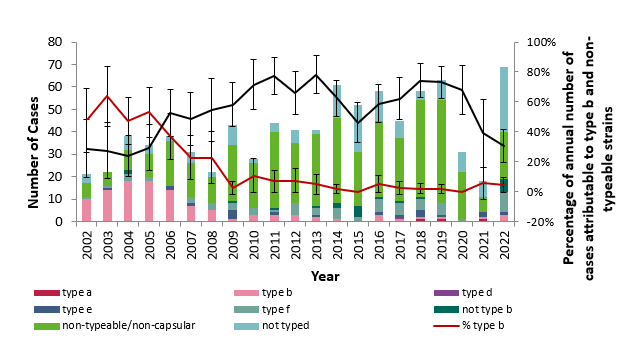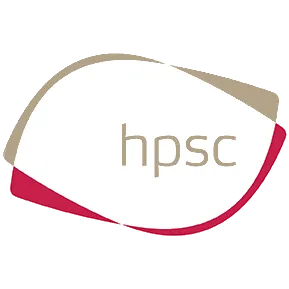Haemophilus influenzae in Ireland
Haemophilus influenzae in Ireland
Haemophilus influenzae is a bacterium that can cause serious infection in humans, particularly in children, but also in individuals with weakened immune systems.
There are a number of strains of H. influenzae. Strains are classified as those with capsules (capsular types) and those without capsules (non-encapsulated types). Six capsular types (a-f) are recognized.
A polysaccharide conjugate vaccine against type b (Hib) infections was introduced in Ireland in September 1992. In 2006 a Hib booster dose was introduced into infant schedule in the second year of life.

Haemophilus influenzae in Ireland, 2022
| 69 | The number of Haemophilus influenzae notifications in 2022 |
| 1.4 | The national notification rate per 100,000 population in 2022 |
Last updated: 03 February 2023
Information for parents and carers on caring for unwell children and when to seek medical assistance is available at: MyChild.ie and HSE.ie - How to stay well in winter
What is Haemophilus influenzae?
Haemophilus influenzae is a bacterium that can cause serious infection in humans, particularly in children, but also in individuals with weakened immune systems.
Are there different types of Haemophilus influenzae?
There are a number of strains of H. influenzae. Strains are classified as those with capsules (capsular types) and those without capsules (non-encapsulated types). Six capsular types (a-f) are recognized. In the prevaccine era, type b was the most commonly reported strain. The non-encapsulated strains cause mucosal infection (such as middle ear infections, called "otitis media") but rarely lead to serious invasive disease.
What is Haemophilus influenzae type b?
H. influenzae type b (also known as "Hib") is just one of six H. influenzae types. Before a vaccine was available to prevent H. influenzae type b disease Hib accounted for approximately 80-95% of all strains that caused invasive illness.
What illnesses does Haemophilus influenzae cause?
Haemophilus influenzae causes a number of diseases. These are:
- Otitis media
- Meningitis
- Pneumonia
- Septicaemia
- Epiglottitis
- Septic arthritis
- Cellulitis
- Osteomyelitis
What illnesses does Hib cause?
Hib can cause the same illnesses as other types of Haemophilus influenzae - but one of the most common and worrying presentations of Hib disease is meningitis.
How is Hib transmitted?
Hib lives in the nose and throat of humans and is transmitted from person to person through respiratory droplets, or contact with respiratory secretions. The bacteria may be carried around in the nose and throat for a short while or for several months without causing symptoms ("asymptomatic carrier"). In some individuals (particularly those most at risk) Hib will invade the body causing invasive disease (e.g. meningitis, septicaemia).
How many cases of Haemophilus influenzae type B occur each year in Ireland?
Between 2013 and 2015 few (three) cases of Haemophilus influenzae type B were notified. Haemophilus influenzae disease (invasive) became a notifiable disease in 2004.
Further information on Haemophilus influenzae figures and trends are available on the HPSC website.
Can Hib be prevented?
Yes, Hib can be prevented with the Hib vaccine. Please see the Immunisation Guidelines for Ireland for more information. Since Hib vaccine was introduced in 1992 there has been a dramatic decrease in the number of invasive Hib cases reported in Ireland.
When is Hib vaccine given to children?
Hib vaccine is offered to all children as part of the routine childhood vaccination programme in Ireland. Hib vaccine is part of the "six-in-one" vaccine and is given at 2, 4 and 6 months of age. In addition all children reaching 13 months of age are now offered a Hib booster at the same time as MenC vaccine to give extra protection against Hib infection.
Unvaccinated children up to 10 years of age should be vaccinated if not previously vaccinated (eg if child came from country where Hib vaccine not administered).
Should anyone else (other than children) get the vaccine?
Hib vaccine is also recommended for individuals who are at risk of Hib infection (see "Who is most at risk of Hib infection?")
Who is most at risk of Hib infection?
- Young children are most at risk of Hib infection, particularly those less than 4 years of age
Other individuals at risk of Hib infection are:
- Individuals with a malfunctioning or lack of spleen, complement deficiency etc irrespective of how old they are - see NIAC guidance on Hib vaccination.
This is a vaccine preventable disease for which there is a national immunisation programme (ie vaccine is free for those recommended it) in Ireland. Visit the HSE National Immunisation Office website for more information on Haemophilus influenzae and Hib vaccination.
Last reviewed: 22nd February 2016
Case definition
Haemophilus influenzae disease (invasive) (Haemophilus influenzae (blood, CSF or other normally sterile site))
Clinical criteria
Any person with clinical picture compatible with invasive disease, i.e. bacteraemia, meningitis, arthritis, epiglottitis, osteomyelitis or cellulitis
Laboratory criteria
At least one of the following two:
- Isolation of Haemophilus influenzae from a normally sterile site
- Detection of Haemophilus influenzae nucleic acid from a normally sterile site
Typing of the isolates should be performed
Epidemiological criteria
NA
Case classification
A. Possible case
A case with clinical epiglottis without any laboratory confirmation or with identification only from a non-sterile site
B. Probable case
NA
C. Confirmed case
Any person meeting the laboratory criteria
Current as of: 24 January 2019



